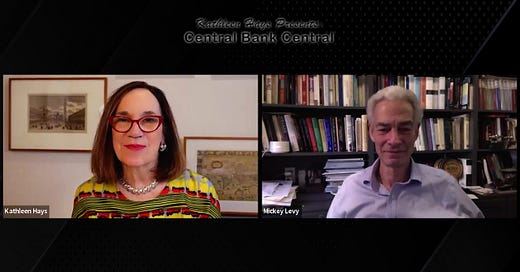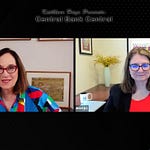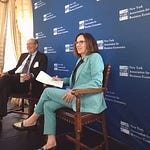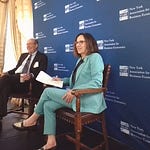The Federal Reserve has been making it clear in speech after speech that that, as Richmond Bank Fed president Tom Barkin told me in our recent interview, there is a “dense fog” hanging over the U.S. economy and until it lifts he will be willing to stay on the sidelines before making any kind of rate move.
And the key to what will get the Fed off the sidelines and ready to move has mainly been tariffs. How much will they boost inflation? Will they lead demand to fall and firms to stop hiring? While the minutes of the Fed’s last meeting didn’t have any definitive answers, Mickey Levy does.
Way back in November when Mickey and I started talking about the impact of tariffs on the economy, he said any boost in prices they caused would be temporary and not cause inflation to rise steadily. Now he says the latest minutes seem to show the Fed starting to realize this is what is happening now: “The Fed's going to start being a little more vocal and saying, Gee! Maybe the impacts are not as large as we had thought.”
As for Fed rate cuts, will they, won’t they? And if they do, when will they be done? Could it come as early as July, as two Fed governors have indicated they could be in favor of supporting?
Dive in and hear why Mickey says the Fed could do its first rate cut of 2025 next month as policy remains a bit restrictive with the effective fed funds rate remaining above inflation, and above the neutral rate. And how he thinks the Fed’s dots could be modified to make them better at signalling to the public where policy could be heading next.
By the way, if you want to hear what Mickey had to say about tariffs just after President Trump got re-elected, you will easily find it among my 252 interviews by searching with his name. Lots of good stuff. I’m glad he came back and joined me for this one.
Fed minutes emphasize better recent outcomes and uncertainty 00:01:20.030
The minutes really emphasize the heightened degree of uncertainty and risk; the Fed did suggest that while the economy may have held up a little better than what they had earlier worried about, that the risks were to the downside, and that while inflation hadn't risen yet in response to the tariffs that the risk on inflation were a little bit to the upside. But basically it's all about risk and uncertainty. And they did say, Gee! It could be. These risks drive our next - our next - change in policy. So basically, we didn't learn much. But the Fed was honest in articulating exactly where it stands.
Scenario analysis: preview of coming attraction? 00:02:39.770
Here it did talk about the how it may measure risks. and how it may incorporate scenario analysis into its monetary policy, deliberations.
The Fed is data dependent- 00:06:23.850
If we consider the fed members. They have access to all the data that all of us see, plus. They hear about anecdotal evidence directly from corporations, and they make a forecast, and some of, and the fed staffers at the Board of Governors. They really control the forecast, the projections of all the governors, and then the Federal Reserve Bank presidents have their own bases for projections. And you know, and so basically a key point I'd like to get across is the FOMC members are data dependent. Like most people in financial markets, they put the most weight on the most recent piece of data.
Data came in better so Fed forecasts were shifted higher 00:07:15.940
And so what we've seen is, oh, the economy has been a little more resilient than the Fed has thought, so they ramp up their projection. They also noted in the minutes that at the time of the meeting the large tax-cut package was moving through Congress, and so that may have, you know, allowed them to be a little more optimistic, that employment growth, had beat their earlier expectations, that inflation had come in a little better. And this is, you know, this is all reflected in their projections. but once again, jay, Powell basically says, and he says correctly, we really should take their quarterly SEPs with a grain of salt, you know, because they're the Fed’s at the time. Best projections, and they they're not always accurate.
Dual purpose DOTS - 00:08:44.470
I think the dots convey the members best projections, or estimates of what the Federal funds rate would/should be at year end. However, you have to add the following element to it. The dots are also used as forward guidance. And, so the dots are basically what the Fed thinks is appropriate to tell the public to achieve
The logic of rate cuts- 00:11:04.900
As you note, there are 4 <more FOMC> meetings during the remainder of this year, and the median once again the median dot has built into it cuts 25 base points, cuts at 2 of those meetings right now. The Fed says it's comfortable with its current position, and I think it is. It has the expectation, or the members have the expectation that there's room to cut rates, for one reason. That is the current effective funds rate and the target of 4 and a quarter to 4 and a half is comfortably above inflation. And if you take the inflation adjusted effective funds rate. It's well above the Fed's estimate of R-star, of the neutral rate of interest. So the Fed says, Okay, we have room to ease. But inflation is still above our target. And we're worried about the inflationary impact of tariffs. And we're worried about the downside risk to the economy imposed by tariffs. And so they're just kind of sitting back and waiting. Now. let's say they do cut rates twice this year, which is built into market expectations. at a time when inflation has been above its 2% target for 4 years now. And so it reflects the Fed’s priority. So, as I've argued, the fed will tolerate some moderation in employment. But if you saw a significant moderation in employment, if inflationary expectations were still fairly well anchored, the highest probability is the Fed's going to cut rates in response to the weakness in labor markets, because that's what it's always done. It always puts a higher priority on labor markets than inflation.
Tariffs offer a unique sort of inflation/growth risk 00:14:08.810
Great question, because the Fed’s preconceived notion is, tariffs are going to raise inflation, but have more of a temporary one-time impact on inflation rather than a permanent impact. and that the tariffs are going to harm the economy and harm labor markets. And so I don't want to read too much into the minutes, but they do suggest that the Fed is kind of beginning to scratch its head and say, Gee! Doesn't seem to have hit inflation that much even one time yet. And employment continues to grow and basically be consistent with the earlier economic, soft landing we had projected. And so you see this coming out and the Fed's still on edge about it. But there, if we have a couple more months of fairly benign data on economic activity and inflation. The Fed's going to start being a little more vocal and saying, Gee! Maybe the impacts are not as large as we had thought.
Less impact on inflation form tariffs than what people think 00:16:05.680
No, my views have not changed. I argued that the impact on tariffs. the impact of tariffs on inflation will be less than what people think particularly PCE inflation. which is heavily skewed toward services like shelter, costs, health costs, and the like, and which our services are not tradable goods so could be in this awkward situation where it has a bigger impact on the on the CPI than the PCE. But I've argued that the tariff shouldn't have that big of an impact on inflation. The other critical point I've emphasized about tariffs is, you know, is in April, when Trump had layered in very high tariffs, and the average effective tariff was over 25%, and he threatened more. I conducted a scenario analysis and put probabilities on the likely outcomes, and I said, by far the highest probability is what I termed the ‘less worse case.’ They all have the word ‘worse’ in them because I'm in favor of free trade and open markets. But I did argue that trump loves to negotiate loves to threaten, that he loves bilateral negotiations. Little by little you would have negotiations, and the average effective rate tariff rate would come down quite a bit. And, we've moved in that direction. And I think we you know it's still in progress, as we've learned this week, but it'll move down further and so I guess I'm not surprised by this very unsavory process, but it all points toward the tariffs which President Trump hangs his hat on. They'll be moderated even from current levels. and their impacts will not be as much as consensus forecasters. Or as the Fed had earlier perceived.
Could the Fed cut rates in July? 00:19:14.840
Yes, I think they could move. So once again, if they do cut rates that would still leave the target. Federal funds rate 4 to 4 and a quarter which is still comfortably above comfortably above inflation, which, by the Feds thinking, leaves them, you know, kind of mildly restrictive
What does the Taylor rule say? 00:19:58.400
Taylor rule says the funds rate should be just about where it is. If you base that onan R star and a real natural rate of interest about 2%. The fed estimates R. Star to be lower than that, however.
Applauds Powell’s resistance 00:20:39.400
I try to think the Fed is not political. And here I'll give Powell a lot of credit for his behavior and the way he's conducted himself and the fed in recent months. Look, we've we all the White House for decades is bickers with the central bank, and always wants lower rates and monetary easing. I do not approve at all of of the way. trump threatens the independence of the fed, and it's totally inappropriate. So I do applaud Powell for what he's doing here
Question for next meeting 00:21:23.260
Mickey Levy: If you ask me the question at the next meeting. Does that pressure from the White House play a role? I mean, you'll never read about it in the minutes. It's lurking in the back of everybody's mind.
Dr. Mickey D. Levy
Mickey Levy is a macroeconomist who uniquely analyzes economic and financial market performance and how they are affected by monetary and fiscal policies. Dr. Levy started his career conducting research at the Congressional Budget Office and American Enterprise Institute, and for many years was Chief Economist at Bank of America, followed by Berenberg Capital Markets. He is a long-standing member of the Shadow Open Market Committee and is also a Visiting Scholar at the Hoover Institution at Stanford University.
Dr. Levy is a leading expert on the Federal Reserve’s monetary policy, with a deep understanding of fiscal policy and how they interact. He has researched and spoken extensively on financial market behavior, and has a strong track record in forecasting. Dr. Levy’s early research was on the Fed’s debt monetization and different aspects of the government’s public finances. He has written hundreds of articles and papers for leading economic journals on U.S. and global economic conditions, and has been an active voice on how financial markets are influenced by monetary policy. He has testified frequently before the U.S. Congress on monetary and fiscal policies, banking and credit conditions, regulations, and global trade, and is a frequent contributor to the Wall Street Journal, Bloomberg, and other media.
He is a member of the Council on Foreign Relations and the Economic Club of New York, and has previously served on the Panel of Economic Advisors to the Federal Reserve of New York, as well as the Advisory Panel of the Office of Financial Research.
Dr. Levy holds a Ph.D. in Economics from University of Maryland, a Master’s in Public Policy from U.C. Berkeley, and a B.A. in Economics from U.C. Santa Barbara.













Share this post